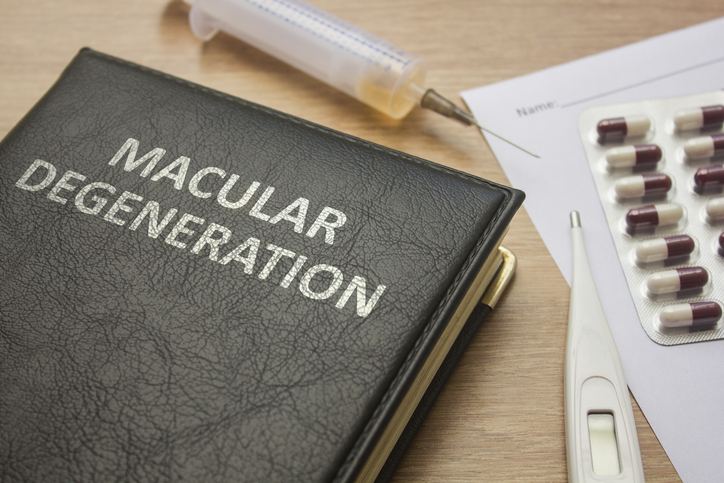Age-related macular degeneration, or AMD, is a progressive disease that causes vision loss. For many people, AMD interferes with everyday life and becomes a source of great distress and anxiety.
Fortunately, specialized treatments can prevent further complications when the condition is caught early. Learn how to take your life back from this progressive disease and restore healthy vision with appropriate macular degeneration treatment.

Understanding Macular Degeneration
Macular degeneration is a progressive eye disease that affects the macula, or the central portion of the eye’s retina. Depending on the subtype, you may notice the appearance of gradual symptoms, or you may experience sudden central vision loss.
General Macular Degeneration Symptoms
If you’re living with the beginning stages of AMD, you may not notice any symptoms. However, as the condition progresses, your central vision will worsen, and you may have trouble seeing objects in front of you. Your peripheral vision will be normal. Some other common symptoms include:
- Blurry vision
- Trouble seeing in dim lighting
- Not being able to see colors correctly
- Wavy or curvy lines that you know should be straight
- Dark spots or blank areas in your vision
An AMD diagnosis may come as a surprise, and many patients report anxiety and depression when living with this condition. For older adults who are used to living independently, the inability to complete tasks and rely on their vision can be frustrating and disheartening. Fortunately, there are many macular degeneration treatment options available.
Dry AMD
In dry AMD, deposits of a protein substance called “drusen” harm the macula over time. This subtype is often treated with lifestyle changes and supplements. Patients with a rarer, more advanced form of dry AMD called geographic atrophy may take advantage of newer treatments that aim to slow this type’s progression. Dry AMD accounts for around 90% of AMD diagnoses.
Wet AMD
Wet AMD is less common, accounting for around 10% of diagnosed cases, but it’s often more treatable than the dry subtype. It involves the growth of abnormal blood vessels in the eye that cause bleeding and swelling in the retina. Depending on the severity of the condition, wet AMD treatment may include injections of a medication that can prevent or reverse further vision loss.
AMD is typically diagnosed in adults who are over 50 — which is why it’s often given the “age-related” designator — but it can occur in younger adults, as well. If you’re having any symptoms related to AMD, regardless of your age, it’s important to seek the opinion of a qualified ophthalmologist.
Treatment Options for Macular Degeneration
Macular degeneration treatment options for AMD depend on the stage of progression, which type of AMD you have, and your overall health. Your ophthalmologist may suggest a conservative approach that includes lifestyle changes and nutrient supplementation, or they may encourage you to begin injections that slow the disease process.
Lifestyle Changes and Early-Stage Management
- Dietary changes: Focus on eating healthy, whole foods such as lean meats, fish that contain high levels of omega-3 fatty acids, colorful berries that contain antioxidants, leafy green vegetables, and healthy fats such as olive oil, nuts, and avocado. Maintaining a healthy eating pattern can help lower inflammation and contribute to your body’s overall health.
- Vision aids: Your doctor may suggest accessibility aids for people with low vision. These items, such as large-print books, audio options for listening instead of reading, and magnifiers, can make life with AMD significantly easier.
- Healthy habits: If you smoke cigarettes, vape, or drink alcohol excessively, now is the time to quit. An unhealthy lifestyle can increase inflammation and increase disease progression.
Medications
If lifestyle changes don’t work well, your ophthalmologist may suggest certain medications and supplements for AMD:
- Anti-VEGF injections: This common treatment uses an injectable medicine to slow the growth of extra blood vessels that are swelling and bleeding. For those with wet AMD, this treatment can be life-changing. Typically, patients return for eye injections for macular degeneration every month. Still, some patients are weaned from their treatment regimen after two years and continue to notice a slower progression of symptoms.
- AREDS supplements: Multivitamin supplements that contain targeted vitamins and minerals such as vitamins C and E, copper, zinc, zeaxanthin, and lutein may help slow the progression of symptoms. These supplements are typically used for dry AMD, though some people with wet AMD may opt to take them for their overall eye health, as well.
Laser Therapy
Some patients need more intensive macular degeneration treatment, like laser photocoagulation therapy. While this is a relatively simple procedure, it’s only appropriate for wet AMD — and your doctor may not recommend surgery if your abnormal blood vessels are spread out across the macula or your symptoms are still very mild.
During laser photocoagulation, the ophthalmologist administers an anesthetic eyedrop and uses a small lens to focus the laser on any abnormal or leaking blood vessels affecting the macula. Burning the extra vessels effectively seals them off so they don’t leak fluid into the macula, which reduces troubling visual symptoms.
Surgical Options
Surgery typically isn’t a first-line consideration for either subtype of AMD. For wet AMD, the laser surgery mentioned in the previous point is typically the most helpful.
For dry AMD with extreme cases of geographic atrophy, there is a certain type of surgery that involves removing the lens of the eye and implanting a tiny telescope lens in its place. This lens can act as a magnifier that enhances and enlarges images in the patient’s central vision. Often, this type of surgery is seen as a last resort. Still, it can be very helpful for patients suffering from poor quality of life and disability due to geographic atrophy.
Importance of Regular Eye Exams
At this point, there is no cure for AMD, but targeted treatments can slow its progression. Regular comprehensive eye exams accomplish much more than checking your vision: Your doctor may screen you for AMD, rule out glaucoma and cataracts, spot signs of developing diabetes, and alert you to numerous other conditions that can affect your eyes.
These appointments are more important as you age. AMD may not cause obvious signs or symptoms until it drastically interferes with your daily life. Catching it early allows for more options and personalized treatment with your eye doctor.
Personalized Macular Degeneration Treatment Plans at Aiello Eye Institute
There are several types of treatment for AMD, and Aiello Eye Institute takes a personalized approach to treating this condition. We aim to consider our patient’s symptoms, goals, and overall case from a holistic viewpoint. If you’re experiencing concerning symptoms, it’s important to consult with an eye care specialist to determine the right treatment plan for your unique life.
Get in Touch
Though macular degeneration can cause troubling visual distortions and vision loss, with early detection and appropriate lifestyle changes, vision aids, or medicine injections, it’s possible to protect your vision from its progression. It’s important to consult with an experienced ophthalmologist to determine your next steps.
If you’re ready to control your AMD symptoms, call Aiello Eye Institute in Yuma, AZ, to schedule your appointment. You can also use our convenient online form to contact us. We look forward to helping you preserve your vision and return to living the life you love.
